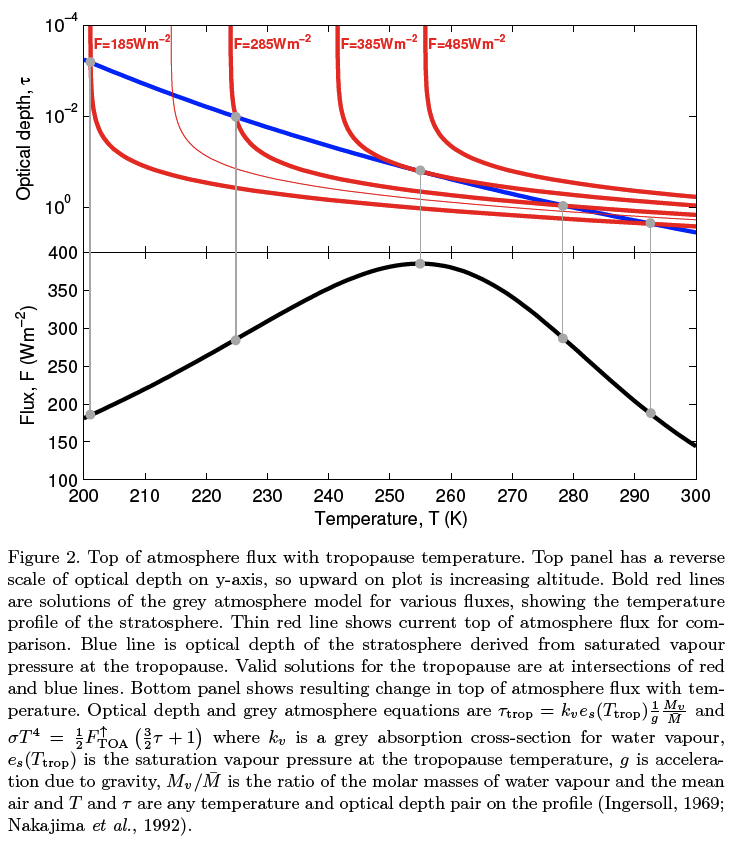Wetting the stratosphere, boiling the oceans
The Capitalist Imperial Pig discusses whether the Earth could go into meltdown, pointing to an article at the MIT Technology Review based on a submission by Colin Goldblatt and Andrew Watson available at arXiv. The manuscript itself is quite clear and differentiates different kinds of runaway warming, the second , and the one Eli will think a bit about comes from determining the vapor pressure of the stratosphere by temperature of the tropopause. In other words, the flux of water vapor into the stratosphere is determined by how much can get through the cold trap at the tropopause.
In radiative equilibrium, the upward longwave flux must equal the downward shortwave flux throughout. Two consequences of this are that the temperature increases with optical depth (this increase is rapid once optical depth > 0.1) and that a higher absorbed shortwave flux will mean that the stratosphere is warmer throughout.They show this in their Figure 2.

A limit on outgoing radiation from the stratosphere arises because the radiative equilibrium temperature profile needs to match the optical depth of the stratosphere, which is set by the saturation vapour pressure at the tropopause. Intuitively, one might think first of the tropopause temperature then of the associated outgoing flux, but the radiation limit is easier to demonstrate by starting with the outward flux. For some given flux, we follow the radiative equilibrium temperature–optical depth profile until it intersects the temperature–optical depth curve derived from the saturation vapour pressure (figure 2). The intersection gives the tropopause . If the outgoing longwave flux is large, no solution can be found—the radiation limit is then the highest flux for which a solution can be found, around 385Wm−2 here.Put this together with Susan Solomon's demonstration a couple of years ago that humans are wetting the stratosphere by increased methane releases, followed by oxidation to water vapor and the bunnies realize that there is another mechanism for what Goldblatt and Watson call "Radiation Limit 2: moist stratosphere upper limit (Komabayashi–Ingersoll limit)", blowing a bunch of methane into the stratosphere.
And where have we seen that discussed? and here too.
Eli, being a lazy bunny, thinks this would require an ungodly methane release, but a massive push of methane into the stratosphere with the associated increase in stratospheric water vapor would bring the Earth into an entirely unique and dangerous situation.





9 comments:
Every plot related to future atmospheric conditions should show that point at which climate change knocks out 50% and 95% of agricultural production, and contain a foot note as to why the author expects us to care about the details of atmospheric conditions after we are on 5% rations.
Hmm, would that much methane tend to saturate the methane-H2O pathway in a similar manner to the CO2 one? All part of the same process, yes, Prof. Bunny?
Does this puts the kibosh on Perry & Inhofe's plan to end dependence on Arab oil by extending the Keystone Pipeline to the methane lakes of Titan?
I asked a climate scientist years ago if the runaway was likely. He said no, we had these conditions before, during the time of the dinosaurs, and no runaway then. I guess you would call him a midwarmer. It is a serious issue that needs to be addressed now, but no runaway is likely.
Anon(1)
Dr. Jay Cadbury, phd.
@Aaron
There should also be a footnote asking whether or not anyone actually believes that would happen.
Anon(1), as noted in the post there are different flavors of runaway. Raypierre's point that a Venus-style runaway isn't possible (based on there being too much gravity and magnetosphere for the solar wind to strip away disassociated hydrogen as occurred with Venus) seems hard to argue with, but I think what Hansen is talking about could best be described as a failed runaway, i.e. one that makes things at best highly unpleasant if not fatal for the biosphere as we know it but is not permanent.
(wv suggests how Chaucer would have characterized Rabbet Run: "fonne")
Anyone here considering the impact from
Methane break down at low latitudes, in the stratosphere into hydrogen oxides, which attack ozone. And nitrous oxide a 300 times more potent greenhouse gas than Co2, which can decompose to form ozone-eating nitrogen oxides (Shindell et al.).
Last year we found out about the ozone hole at the north pole which affects roughly 700 million inhabitants of the northern hemisphere.
Long lived CFC’s, Methane, Nitrous Oxide uptake and the destruction of the northern hemisphere Ozone Layer
http://climateforce.net/2012/01/24/long-lived-cfcs-methane-nitrous-oxide-uptake-and-the-destruction-of-the-northern-hemisphere-ozone-layer/
Dr. Jay Cadbury, phd.
@prokaryotes
whatever we're doing, I say continue doing it. I live in the northern hemisphere and the air I'm breathing has never been better.
Post a Comment